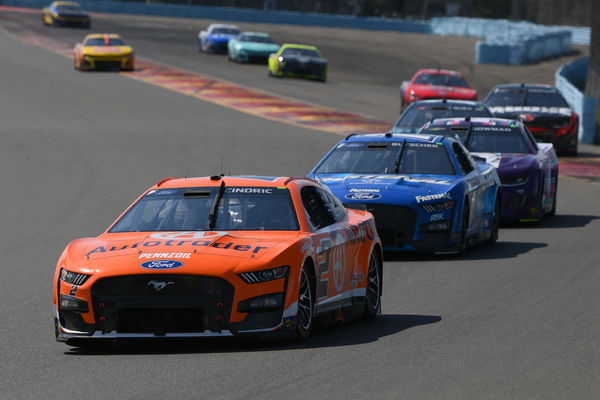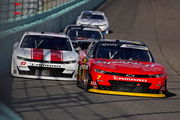
USA Today via Reuters
Aug 20, 2023; Watkins Glen, New York, USA; NASCAR Cup Series driver Austin Cindric (2) leads a group of cars during the Go Bowling at The Glen at Watkins Glen International. Mandatory Credit: Rich Barnes-USA TODAY Sports

USA Today via Reuters
Aug 20, 2023; Watkins Glen, New York, USA; NASCAR Cup Series driver Austin Cindric (2) leads a group of cars during the Go Bowling at The Glen at Watkins Glen International. Mandatory Credit: Rich Barnes-USA TODAY Sports
It’s no secret that NASCAR has had problems in improving the quality of its short-track races. Despite countless theories being proposed, and ideas implemented, getting the Next Gen car to race at a level deemed acceptable while utilizing the short-track package has seemed like an insurmountable task. Drivers and crew chiefs haven’t held back from criticizing Goodyear, while the tire manufacturer continues to work on a tire compound that satisfies everybody.
With the Cup Series heading towards Richmond Raceway after the Olympics break, NASCAR is offering teams the option to choose between two tire compounds, the first time such an opportunity is being presented in a points-paying race. As for Goodyear, they are already working on improving the short-track package, as revealed by Mark Keto, NASCAR project manager for Goodyear.
ADVERTISEMENT
Article continues below this ad
Goodyear working towards improving the short-track package
NASCAR’s short track package has come under intense scrutiny since the Next Gen car was unveiled in 2022. Unlike intermediate tracks, where the racing quality has improved significantly, the Cup short tracks have continued to struggle for the most part. That was until Bristol Motor Speedway, where excessive tire wear forced drivers to improvise on track, with those who knew how to manage their tires being rewarded. While Denny Hamlin officially won that race, the biggest winner at the event was NASCAR and Goodyear.
The sanctioning body and tire manufacturer have been working together ever since, hoping to improve the short-track package. Speaking to Racer Magazine’s Kelly Crandall on The Racing Writer’s Podcast, Mark Keto has hinted at a possible development in that regard. He said, “We’re already looking forward to the next race. We’re building tires for the races in early September now and moving on with those. Also, we have been really busy, we have a Martinsville Cup coming up, looking at some of the short-track stuff that we have been working on. We have a Martinsville Cup coming up, I believe it’s on a Tuesday and Wednesday, right after Michigan, so that’s some of the stuff we have been busy with.”

It seems like NASCAR has been taking the feedback about short-track racing seriously. Earlier this year, the first 30 laps in Richmond were on wet tires due to the damp surface on the track. As the tires wore out, multiple lanes were created, which enabled cars to overtake each other on the track. However, as the track dried, and teams went back to their regular tires, racing reverted to a single-file structure, a longstanding criticism about short-track racing.
ADVERTISEMENT
Article continues below this ad
What’s your perspective on:
Can Goodyear's new approach finally fix NASCAR's short track woes, or is it just more empty promises?
Have an interesting take?
However, with NASCAR giving teams an option to choose between two types of Goodyear tires at Richmond Raceway, it will result in a sense of unpredictability. Teams will have the option to go with a softer option with lesser durability or a harder option with longer durability, which could improve the entertainment value and enhance race dynamics, as teams will have to devise their tire strategy. A 45-minute practice session will give teams the chance to practice each tire compound, and while teams will have to qualify on prime tires, they have the freedom to choose whatever compound they like during the race, as long as the tires are not mixed.
Trending
Why did NASCAR offer a two-tire strategy for Richmond Raceway?
While drivers have been craving more horsepower as a solution to NASCAR’s short-track woes, an unexpected solution was brought about at Bristol Motor Speedway, when cars experienced higher-than-normal tire wear. As a result, the race was one of the best short-track events, as drivers were forced to manage their tires, while teams had to devise their strategy. Keeping that in mind, NASCAR is hoping to replicate a similar outcome at another short-track venue, when Cup Series action returns to Richmond Raceway after the Olympics break.
ADVERTISEMENT
Article continues below this ad
Hoping that this change will improve the short-track package, Elton Sawyer, NASCAR’s senior vice president of competition said, “This past year, it gave us the chance to try something with tires, and we’re working really hard in NASCAR as well as the folks at the R&D center to improve the short-track package. We didn’t get the results at Wilkesboro that we were hoping for, with a very similar opportunity that we had at Bristol where we did see results, and even at Iowa where we did as well. Any time we can put our teams in a position where they have to manage tires, we really see some great racing and we see an entertaining race, so that’s our goal going into Richmond.”
While having multiple tire compounds for a race might be commonplace in other motorsports, it has been unique in NASCAR until now. The option to provide multiple tire options was first tested in the 2017 All-Star race, leading to an underwhelming outcome, as there was little speed difference between the two tire compounds. This time, there is much more at stake, as the Federated Auto Parts 400 is a points-paying race. Moreover, teams are expected to go with the standard tires for a normal fuel run, while the option tire, made up of a softer compound, will be utilized as a short-term solution to quickly gain track positions. While NASCAR continues to work on improving its short-track package, it’s interesting to see how the Richmond Raceway experiment fares.
Have something to say?
Let the world know your perspective.
ADVERTISEMENT
ADVERTISEMENT
ADVERTISEMENT
ADVERTISEMENT






Can Goodyear's new approach finally fix NASCAR's short track woes, or is it just more empty promises?